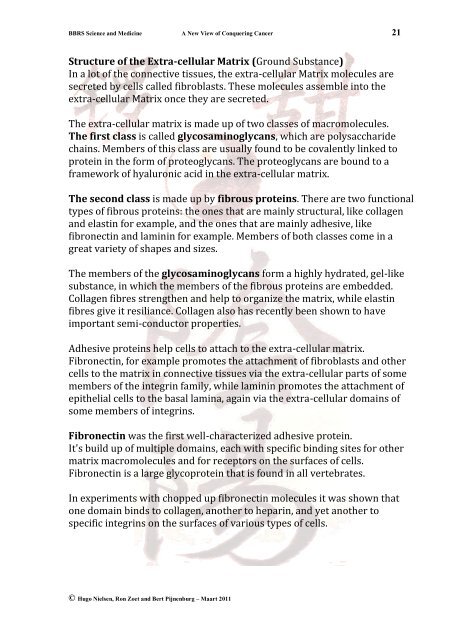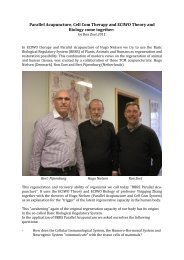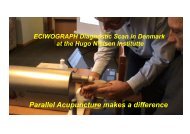BBRS SCIENCE AND MEDICINE RON ZOET Biocommunication ...
BBRS SCIENCE AND MEDICINE RON ZOET Biocommunication ...
BBRS SCIENCE AND MEDICINE RON ZOET Biocommunication ...
Create successful ePaper yourself
Turn your PDF publications into a flip-book with our unique Google optimized e-Paper software.
<strong>BBRS</strong> Science and Medicine A New View of Conquering Cancer 21<br />
Structure of the Extra-cellular Matrix (Ground Substance)<br />
In a lot of the connective tissues, the extra-cellular Matrix molecules are<br />
secreted by cells called fibroblasts. These molecules assemble into the<br />
extra-cellular Matrix once they are secreted.<br />
The extra-cellular matrix is made up of two classes of macromolecules.<br />
The first class is called glycosaminoglycans, which are polysaccharide<br />
chains. Members of this class are usually found to be covalently linked to<br />
protein in the form of proteoglycans. The proteoglycans are bound to a<br />
framework of hyaluronic acid in the extra-cellular matrix.<br />
The second class is made up by fibrous proteins. There are two functional<br />
types of fibrous proteins: the ones that are mainly structural, like collagen<br />
and elastin for example, and the ones that are mainly adhesive, like<br />
fibronectin and laminin for example. Members of both classes come in a<br />
great variety of shapes and sizes.<br />
The members of the glycosaminoglycans form a highly hydrated, gel-like<br />
substance, in which the members of the fibrous proteins are embedded.<br />
Collagen fibres strengthen and help to organize the matrix, while elastin<br />
fibres give it resiliance. Collagen also has recently been shown to have<br />
important semi-conductor properties.<br />
Adhesive proteins help cells to attach to the extra-cellular matrix.<br />
Fibronectin, for example promotes the attachment of fibroblasts and other<br />
cells to the matrix in connective tissues via the extra-cellular parts of some<br />
members of the integrin family, while laminin promotes the attachment of<br />
epithelial cells to the basal lamina, again via the extra-cellular domains of<br />
some members of integrins.<br />
Fibronectin was the first well-characterized adhesive protein.<br />
It's build up of multiple domains, each with specific binding sites for other<br />
matrix macromolecules and for receptors on the surfaces of cells.<br />
Fibronectin is a large glycoprotein that is found in all vertebrates.<br />
In experiments with chopped up fibronectin molecules it was shown that<br />
one domain binds to collagen, another to heparin, and yet another to<br />
specific integrins on the surfaces of various types of cells.<br />
© Hugo Nielsen, Ron Zoet and Bert Pijnenburg – Maart 2011





